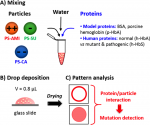
The coffee-ring effect denotes the accumulation of particles at the edge of an evaporating sessile drop pinned on a substrate. Because it can be detected by simple visual inspection, this ubiquitous phenomenon can be envisioned as a robust and cost-effective diagnostic tool. Toward this direction, here we systematically analyze the deposit morphology of drying drops containing polystyrene particles of different surface properties with various proteins (bovine serum albumin (BSA) and diff erent forms of hemoglobin). We show that deposit patterns reveal information on both the adsorption of proteins onto particles and their reorganization following adsorption. By combining pattern analysis with adsorption isotherm and zeta potential measurements, we show that the suppression of the coffee-ring effect and the formation of a disk-shaped pattern is primarily associated with particle neutralization by protein adsorption. However, our fi ndings also suggest that protein reorganization following adsorption can dramatically invert this tendency. Exposure of hydrophobic (respectively charged) residues can lead to disk (respectively ring) deposit morphologies independently of the global particle charge. Surface tension measurements and microscopic observations of the evaporating drops show that the determinant factor of the deposit morphology is the accumulation of particles at the liquid/gas interface during evaporation. This general behavior opens the possibility to probe protein adsorption and reorganization on particles by the analysis of the deposit patterns, the formation of a disk being the robust signature of particles rendered hydrophobic by protein adsorption.

N’hésitez pas à consulter le communiqué de presse associé à cet article : Détecter une maladie génétique avec une « tache de café » !
References:
Protein Adsorption and Reorganization on Nanoparticles Probed by the Coffee-Ring Effect: Application to Single Point Mutation Detection
Devineau S, Anyfantakis M, Marichal L, Kiger L, Morel M, Rudiuk S, Baigl D.
J. Am. Chem. Soc 2016, 138, 11623–11632
doi: 10.1021/jacs.6b04833
Protein Adsorption and Reorganization on Nanoparticles Probed by the Coffee- Ring Effect: Application to Single Point Mutation Detection
